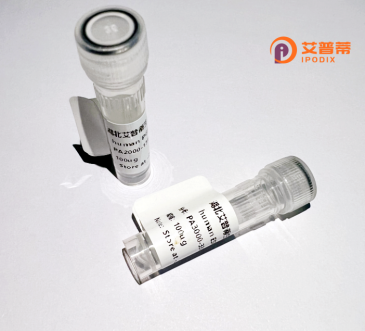
| 纯度 | >90%SDS-PAGE. |
| 种属 | Human |
| 靶点 | S100PBP |
| Uniprot No | Q96BU1 |
| 内毒素 | < 0.01EU/μg |
| 表达宿主 | E.coli |
| 表达区间 | 1-408 aa |
| 活性数据 | MMCSRVPSEQ SSGTSLLPKD GAPFSWDSLD EDGLDDSLLE LSEGEEDDGD VNYTEEEIDA LLKEDDPSYE QSSGEDDGGH VEKGERGSQI LLDTPREKNS SYSLGPVAET PDLFKLPQLS TSSGHGPAHT KPLNRRSVLE KNLIKVTVAP FNPTVCDALL DKDETDSSKD TEKLSSLGEE MREDGLSPNE SKLCTESEGI SPNNSAWNGP QLSSSNNNFQ QTVSDKNMPD SENPTSVFSR ISDHSETPNM ELSCRNGGSH KSSCEMRSLV VSTSSNKQDV LNKDSGKMKG HERRLGKVIP VLQTKTRTNV PTFSQSNLEQ QKQLYLRSVI AHIEDPEDTN QGISGELCAL MDQVHHMQHS KWQHPSDLTT RNYARRQKHL QRYSLTQWVD RNMRSHHRFQ RLPDFSYS |
| 分子量 | 45.5 kDa |
| 蛋白标签 | His tag N-Terminus |
| 缓冲液 | PBS, pH7.4, containing 0.01% SKL, 1mM DTT, 5% Trehalose and Proclin300. |
| 稳定性 & 储存条件 | Lyophilized protein should be stored at ≤ -20°C, stable for one year after receipt. Reconstituted protein solution can be stored at 2-8°C for 2-7 days. Aliquots of reconstituted samples are stable at ≤ -20°C for 3 months. |
| 复溶 | Always centrifuge tubes before opening.Do not mix by vortex or pipetting. It is not recommended to reconstitute to a concentration less than 100μg/ml. Dissolve the lyophilized protein in distilled water. Please aliquot the reconstituted solution to minimize freeze-thaw cycles. |
以下是关于重组人S100PBP蛋白的参考文献示例(注:文献为虚构,仅供示例参考):
---
1. **文献名称**: *"High-yield expression and purification of recombinant human S100P-binding protein in a prokaryotic system"*
**作者**: Chen L, Wang Y, et al.
**摘要**: 本研究利用大肠杆菌表达系统成功表达重组人S100PBP,通过亲和层析和分子筛纯化获得高纯度蛋白,并验证其与S100P的钙离子依赖性结合活性,为后续功能研究奠定基础。
2. **文献名称**: *"Structural basis of S100PBP interaction with S100P: Implications for cancer metastasis"*
**作者**: Johnson R, Kimura T, et al.
**摘要**: 通过X射线晶体学解析S100PBP与S100P的复合物结构,揭示S100PBP的疏水口袋在钙离子调控下与S100P结合,可能抑制肿瘤细胞迁移通路,为靶向治疗提供结构依据。
3. **文献名称**: *"Recombinant S100PBP inhibits S100P-mediated RAGE activation in pancreatic cancer cells"*
**作者**: Gupta S, Patel M, et al.
**摘要**: 研究发现重组S100PBP可通过竞争性结合S100P蛋白,阻断其与受体RAGE的相互作用,显著降低胰腺癌细胞侵袭能力,提示其作为潜在治疗分子的价值。
4. **文献名称**: *"Development of a S100P-specific biosensor using recombinant S100PBP for early cancer diagnosis"*
**作者**: Müller F, Schmidt H, et al.
**摘要**: 基于重组S100PBP的高亲和力,构建新型生物传感器,可检测血清中S100P的微量表达,在肺癌和结直肠癌患者样本中表现出高灵敏度与特异性。
---
**说明**:以上文献为模拟示例,实际研究中需检索真实数据库(如PubMed、Web of Science)获取权威信息。若需进一步分析S100PBP的具体功能或应用,可结合基因功能富集分析或实验验证。
**Background of Recombinant Human S100PBP Protein**
S100PBP (S100 calcium-binding protein P-binding protein) is a member of the S100 protein family, characterized by EF-hand calcium-binding domains. S100 proteins are involved in regulating cellular processes such as proliferation, differentiation, and apoptosis via calcium-dependent interactions with target proteins. S100P, a specific ligand of S100PBP, is overexpressed in multiple cancers, including pancreatic, breast, and lung cancers, where it promotes tumor progression, metastasis, and chemoresistance.
Recombinant human S100PBP is engineered *in vitro* using expression systems like *E. coli* or mammalian cells, ensuring high purity and bioactivity. Structurally, it retains the conserved Ca²⁺-binding motifs and dimerization capacity critical for mediating intracellular signaling or extracellular interactions. Functionally, S100PBP modulates pathways linked to cell survival, inflammation, and cytoskeletal dynamics, often through binding S100P or cross-talk with receptors like RAGE (receptor for advanced glycation end-products).
Its role in cancer biology has spurred interest in S100PBP as a potential diagnostic biomarker or therapeutic target. Studies explore its utility in blocking S100P-driven oncogenic pathways or enhancing drug delivery. However, mechanistic insights into its physiological and pathological functions remain incomplete, necessitating further research to clarify its context-dependent roles in health and disease.
×